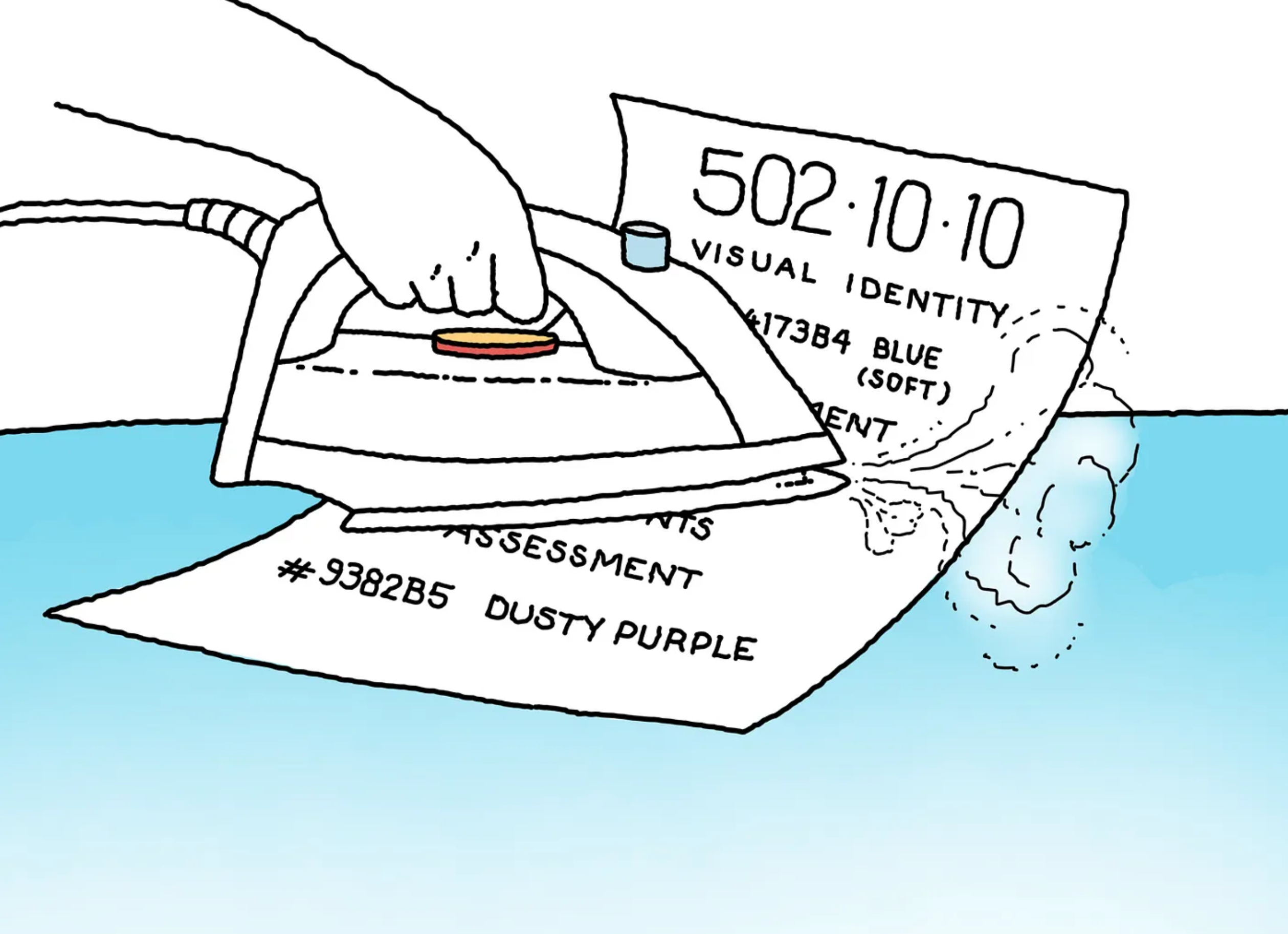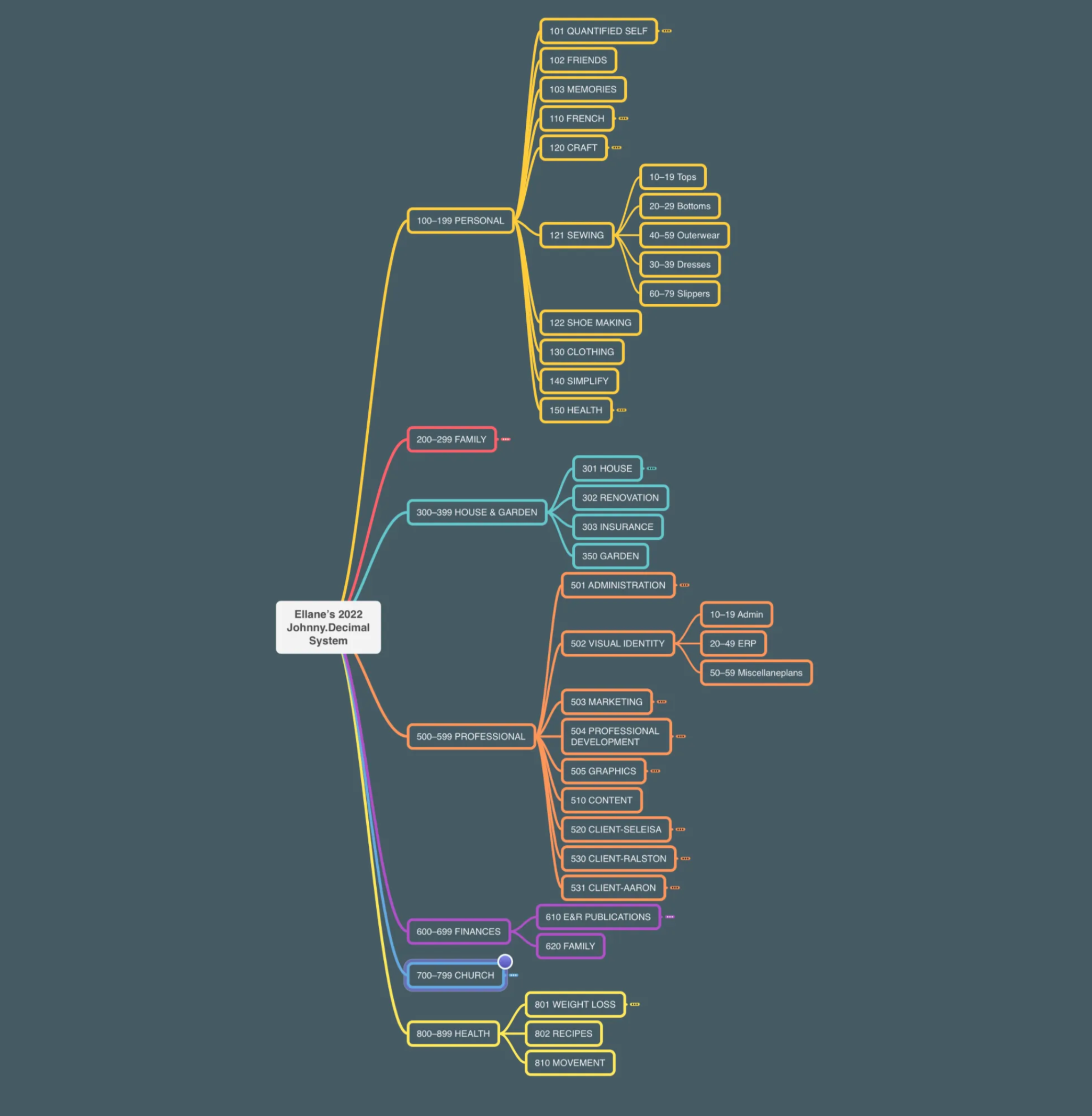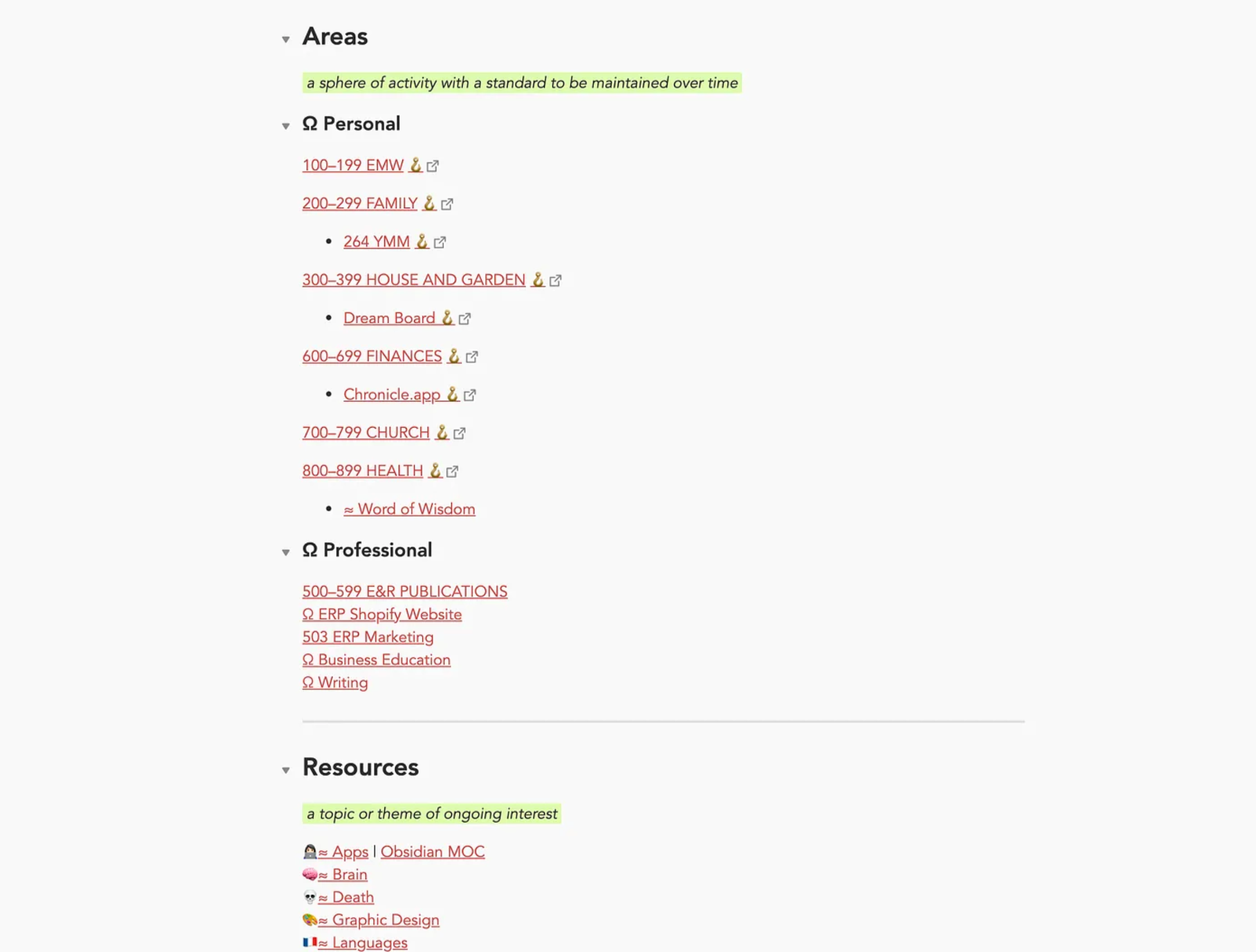
Since this article was published I’ve started using Johnny’s Life Admin system, which is comprehensive and far superior to the still okay approach you’ll find below.
When I first saw people feverishly setting up their Johnny Decimal number categories and evangelising about the benefits, I was intrigued.
I have to say, I wanted what they had: the sense of order, the neat rows of numbers, the library-like efficiency of it all.
They’re not the only clever button in the jar, thought I. If they can do this, I can, too! So I took a gander at what it would take to catalog my life. A very brief gander, if I’m being completely honest.
Within moments I picked up that, clever button or not, this was not going to work for me. No no no no no. I needed more freedom, more flexibility than that, thank you very much! I wasn’t about to shackle myself to a time-wasting, brain-pickling system that required an ultra-specific slot for everything.
Why would I choose to constrain my precious creative brain this way? Folders, shmolders. Haven’t they heard of tags?
Back I went to the drawing board, eventually finding and embracing Tiago Forte’s P.A.R.A. system and feeling that I’d come home, at last.
Tiago is a genius. I’ve written in the past about how his P.A.R.A. system transformed the way I organise my digital files. Shifting documents into broad categories determined by their actionability was just the freedom I was looking for.
But it wasn’t enough.
Some files that I need to refer to often, like the document with the hex codes for my company’s visual identity, were always hard to find, for some reason. What did I call that file, again? Does it live in my Marketing folder, or my Website folder?
It was the frustration of constantly misplacing the same files, over and over, that sparked the realisation that I needed a much more granular system for at least some of my digital world.
Enter Johnny Decimal, again. The time was right, so I embraced it with a smile.
The gamechanger for me was learning there’s no need to choose between JD and PARA; they’re both tools to be used, for the jobs that suit them best. In my system they sometimes stand independently, while other times they work beautifully in tandem.
Eleanor Konik recently wrote a great article encouraging people not to dismiss the use of folders for organising documents.
Her main reason for thinking this way? Backwards compatibility.
Tags can be helpful in some situations, Konik says, but they tend to work differently depending on the interface you’re using to view them. Folders, however, have been around from day one. and will probably always be readable no matter what fancy new systems arise in the future.
I also really appreciate that the Johnny Decimal system is a framework, not a template. It’s a philosophy, which clear logic and reasoning. — Eleanor Konik
You can see this article along with Eleanor’s Johnny Decimal set up, here.
What you are attempting to organise will determine how you apply the Johnny Decimal system. Do you need it for work only? For a few select projects? Or are you trying to organise your entire life?
Read the documentation at johnnydecimal.com several times before committing to anything. No, really; read it, then re-read it, as many times as it takes for the information to feel at home in your head. Make yourself a mind map and be prepared to change it as your thinking and needs evolve.
I ignored Johnny’s advice about taking a full week, and dove straight in after a couple of days of intense study to try out what I thought would work. I find it very helpful to try things on for size, and I don’t mind having to change things in the initial stages. And change things, I did!
It took quite a while to realise that I needed the three-digit system rather than the standard 2-digit original setup.
My Johnny Decimal is a whole-of-life organising system. It works for me, but may not work for you. It’s so important to look at your unique needs rather than copying what someone else is happy with!
Keeping that in mind, here’s my basic outline as it currently stands. Mindmap done in MindNode.

My Family section has the first few numbers dedicated to things like Insurance, and Family History. I’ve also assigned a number to each extended family group.
So my first daughter is number 251, with her husband and children being assigned as follows:
If she goes crazy and has 8 more children, I’ll split those numbers to a range of 5 each child, rather than 10. For now, though, I just stick everything to do with this daughter’s family into folder 251. As the number of documents associated with each person grows, I’ll start assigning numbers to them.
I approach Johnny Decimal the same way I approach ironing. I don’t iron clothes because they’re wrinkly; I iron what I want to wear that day because I don’t like wearing wrinkly clothes.
If you’re an iron-it-because-it’s-wrinkly kind of person, you’ll probably also give every file a number from the get-go. Go for it, I say! But keep in mind that a basket of unironed clothes/unnumbered files is okay too, as long as each basket/folder contains things that go together.
My master Index page in Obsidian is a nice mixture of PARA and JD. Where you see a hook icon followed by a rectangle with an arrow, that’s a direct link to the associated folder on my computer.

Plain text linking to real files, no matter the format? That’s powerful! I do this with Hook on my Mac, as I mentioned before. If you know of other ways to do it, please let me know in the comments. This is a work in progress, not a finished product, but it’s beautifully functional even so.
Johnny says you’ll ignore this piece of advice at your peril. Sigh! I’m not very good at it yet, but it’s early days still. I don’t have many numbers assigned yet beyond the top level categories; my JD folders are more like hold-alls that I’m gradually assigning numbers to as it makes sense to do so.
I’ve set up a Numbers document to keep a record of the itty bitty details of my system as it expands, but I haven’t gotten serious with it yet.
Here’s a tip for Numbers you probably already know, which was new to me. To fill the cells below a given range of cells with numbers that follow the pattern of the originals, select them, then pull down (or across) on the little yellow dot that appears. Gosh, I wish I’d learned that years ago! Super handy.
Once you have your JD index file set up, drag it into the sidebar of your Finder window. If you can see it, you’ll be more likely to keep it up to date. I also have an iOS Shortcut set up on my iPad for opening that specific Numbers file, sitting neatly in a 4 shortcut widget on my homescreen.
Now, each time you add a document to one of the Johnny Decimal folders on your computer, you’ll enter that number in your index file. If a number is written, it’s being used. You don’t have to write what it’s used for if you don’t want to, but you should record that it has been used so you’ll know what the next available number is.
The purpose of this index is not to record the individual contents of every single Johnny.Decimal item: it is only to record the IDs that you have assigned.
—Johnny Decimal website
The same thing applies to applying a JD number to a file in your second brain. When one of your PKM files needs a JD number, you need to be able to see at a glance which ones haven’t been used. Doubling up is a future pain you don’t need.
This is my favourite part!
Searching for files I use often is now a delight. I impress myself daily with how easily I can remember at least the first part of the JD number I’m looking for. I still get a kick when I can remember the whole thing! That visual identity file I talked about above? The one I was always losing? Lost, no more: it’s 502.10.10. Bam!
Here’s a search tip you’ll want to keep in mind when looking for Johnny Decimal files in Obsidian. When you have a lot of backlinks, a regular search for 502. will bring up all the files which contain a link to the 502 file you’re looking for. Depending on how many times you’ve linked to the file in question, file 502.x could be buried somewhere in a long list of files that merely mention it.
Here’s the answer: preface your search with file: Searching for file:502. will bring up only those files with 502. in the file name.
The dot after the number is important when searching. It eliminates phone numbers, date/time ID blocks (eg 202205021034) and most dollar values, honing me straight in to the short list of numbers related to files in section 502 of my Johnny Decimal system.
Of course, if I remember that the file I’m looking for is 502.10.10, popping that into the search box (preceded by file:) will bring up that file all by itself.
When you know you want to keep a document but you don’t yet know which exact part of your Johnny Decimal system it belongs in, fall back on P.A.R.A. Ask yourself these questions:
The time may come that you need to refer to a document on a regular basis, and in that case a Johnny Decimal number will almost certainly suggest itself.
If you regularly find yourself needing to refer to this document in more than one context, store it in the place you tend to think of looking for it first—then make a note of its reference number in the second location.
To make things super convenient, you can utilise a utility like Hook to create a link directly to the file in question.
If you’re not ready for the Johnny Decimal System, if the time isn’t right, leave it well alone. Please. (That’s the voice of your future self. They know what they’re talking about.)
Toying with a cool system that someone else loves, but which doesn’t suit you, will lead to a huge mess of tangled regrets. A disaster you’ll have to unpick if/ when your time for it does come.
When you are ready for it, my friend, you’ll know.
It will call to you, singing sweet songs of freedom, rather than beckoning with chains of steel in its beady, unrelenting gaze. And you’ll answer the call with confidence, knowing that whether striding or taking baby steps, you’ll always have your most important files at your fingertips.
Having an incomplete, imperfect system is something to be proud of. Buffeted by life, it will change shape over time until it fits you perfectly.
Here are the most important things I’ve learned when incorporating Johnny Decimal into my life, and my second brain in Obsidian —
Having an incomplete, imperfect system is something to be proud of. Buffeted by life, it will change shape over time until it fits you perfectly. Once that happens, I hope you’ll write about it so that people just like you can be inspired by your journey!
See also The New Johnny.Decimal Workbook— What I’ve Learned So Far
💬 Comment on Mastodon · or by email
Follow my RSS feed, or sign up to receive posts in your inbox
If the things I post bring you value, please consider contributing to the support jar
 You Need to Back Up Your Paper or Paperless Planner NOW—Here’s How
You Need to Back Up Your Paper or Paperless Planner NOW—Here’s How
 Is Touch Typing Irrelevant in a Voice-to-Text World?
Is Touch Typing Irrelevant in a Voice-to-Text World?